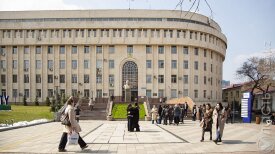Speaking at the Astana International Forum on May 29, Gurbuz Gonul, director for country engagement and partnerships at the International Renewable Energy Agency (IRENA), said that the organization’s new initiative could spur cooperation on the renewable energy sector across Central Asia.
In the past decade, renewable energy has developed in the region beyond the traditional hydropower use in Kyrgyzstan and Tajikistan, where hydroelectric plants produce more than 75% and 92% of the electricity respectively.
In both Kazakhstan and Uzbekistan, countries that heavily relied on fossil fuels for electricity generation, the rate of renewable energy generation is growing, sparking the interest of foreign investors as well as promoting the idea of regional cooperation.
IRENA’s Accelerated Partnership for Renewable Energy in Central Asia (APRECA) was unveiled last year at COP29 in Baku, Azerbaijan.
“Central Asian countries are exploring ways to increase the use of renewable energy to address the rising demand for energy, diversify their energy mix, support economic growth and meet climate objectives,” the document said.
Countries in the region are heavily reliant on oil, gas, and hydropower for electricity generation and are striving to move towards greener solutions.
“Central Asian countries are [...] adopting sustainable development and decarbonization strategies, which demonstrates the seriousness of their intentions,” IRENA’s general director Francesco La Camera said at a climate forum in Samarkand in April.
On June 4, Kyrgyzstan’s ministry of water resources announced the start of construction works at the country’s first wind farm at Balykchy, near Lake Issyk-Kul. Until now, Kyrgyzstan’s renewable energy efforts had stopped at hydropower projects along its rivers.
Growing Ambitions
“IRENA’s ambition is rising in the region and there is a need for a strong cooperation network, which is why we came up with APRECA,” Gonul said.
The initiative’s three-pronged approach focuses on accelerating the deployment of renewables, promoting interconnectivity within the region and across regions, and linking the green transition with developmental goals.
“We want to maximize socio-economic benefits coming from the energy transition,” Gonul said.
In Central Asia, according to Gonul, the lack of infrastructure is the main stumbling block. “The grid comes first,” he argued.
In fact, the grid in Uzbekistan is struggling to keep up with the solar boom in the country, where 11 solar plants and three wind farms are operational.
In May, Uzbekistan generated a record 1.1 billion kWh from solar and wind sources, the ministry of energy reported on June 2. Intermittent power sources such as solar and wind could put a strain on grid infrastructure used to uninterrupted and planned flows of electricity.
“The grids need expansion, modernization, and digitalization,” Gonul said.
Presenting itself also as an investment platform, IRENA focuses also on developing policies together with the local governments.
“A broader policy framework and regulatory measures would create a conducive environment for investment, not only in renewables, but also energy efficiency, critical minerals, and green hydrogen,” Gonul said.
IRENA already provided a financing platform for 900 MW-worth of solar projects in Uzbekistan.
While Uzbekistan’s solar industry is booming, Kazakhstan’s installed solar capacity is also growing, but at a more moderate pace. The strong coal lobby in the country could have something to do with the sluggish pace of Kazakhstan’s energy transition.
Increasingly cheaper auctions for wind power could also help advance solar projects within the same framework.
On May 26-28, a number of auctions for wind projects in Kazakhstan set a minimum price between 11.5-13.9 tenge (just above 2 cents) per kWh, one of the cheapest results for the domestic market.
“Central Asia has a vast potential for renewables and cost is not an issue anymore. The numbers speak for themselves: 80% of installed renewables are cheaper than fossil fuel alternatives. Solar is generally half price compared to fossil fuel. And renewables are also much faster to install. If you are serious about climate goals, speed matters,” Gonul said.
Marketing Renewables
After the session, Gonul spoke to Vlast about the challenges to introduce market-based mechanisms in countries with highly-subsidized utility prices, such as Kazakhstan.
“Obviously, subsidized electricity prices are a challenge, because this hinders the market from operating at full capacity,” Gonul said.
The IRENA director welcomed the transition to an auction system in Kazakhstan, but warned of potential internal squabbles.
“Auctions could spur a very fierce competition, sometimes to the detriment of the government, sometimes to the detriment of the companies. In some cases, this means that the projects will not materialize at all, and that's why it's extremely important to how you design your auctions, as well as what measures you undertake to avoid failure,” Gonul told Vlast.
Policy is crucial in defining the goals of these auctions.
“It could be that your ambition is not just finding the lowest cost, because it could instead focus on your developmental goals. Maybe you want to kickstart the market, or you want to develop your own manufacturing capacities, or you want to put local content requirements – although WTO would not like that – but there are mechanisms to create more economic value and more development impact in the country,” Gonul said.
Circling back on APECA, Gonul said that Kazakhstan has not yet requested their services, but that IRENA has already started working with Uzbekistan.
“One of our first steps was to deal with the problem of the fast and large-scale solar deployment in Uzbekistan, which is affecting the entire region, because it emerged so fast that the grid is insufficient,” Gonul said.
Compared to the speed of solar deployment, “it takes much longer to build the grid and catch up,” Gonul said, hinting that an integrated plan should be worked out across Central Asia “because this is not only affecting Uzbekistan, but also the whole region.”
NOTE: A condensed version of this article was published in Vlast To The People, our English-language newsletter, on June 1. Sign up here if you haven't already.
Поддержите журналистику, которой доверяют.









